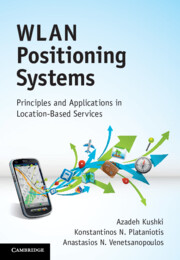5 - Positioning in wireless local area networks
from Part II - Signal processing theory
Published online by Cambridge University Press: 05 February 2012
Summary
In the first part of this book, we motivated the need for accurate and cost-effective positioning systems that can enable the delivery of location-based services (LBS). Moreover, we suggested positioning based on wireless local area networks as a cost-effective and reliable solution for supporting such services in indoor environments. The second part of this book provides an in-depth treatment of the technical fundamentals of these systems. This chapter will begin by providing an overview of wireless local area networks (Section 5.1) and the radio features that can be used for positioning in these networks (Section 5.2). After motivating the use of received signal strength as the feature of choice for positioning, we proceed to describe the details of the experimental data set used for illustrating various concepts in this book (5.3). This is followed by a discussion of the spatial and temporal properties of received signal strength (Section 5.4), challenges in using this radio feature (Section 5.6), and techniques for modeling the relationship between received signal strength and position (Section 5.5).
Wireless local area networks
Wireless local area networks (WLANs) are radio-based communication network infrastructures based on the IEEE 802.11 family of standards. These networks operate in the unlicensed frequency bands [27], primarily employing the 2.4 GHz ISM band. As shown in Figure 5.1, WLANs use an architecture that relies on a set of base-stations for facilitating communication among the devices within the network, and between the network and the outside world (for example, the Internet).
- Type
- Chapter
- Information
- WLAN Positioning SystemsPrinciples and Applications in Location-Based Services, pp. 55 - 67Publisher: Cambridge University PressPrint publication year: 2012



